Why Nesting Boxes?
As any chicken keeper knows, having chickens as part of your backyard flock is a rewarding and fun experience. From providing fresh eggs to providing companionship and entertainment, chickens quickly become an integral part of the family.
An essential part of keeping chickens is providing them with a safe, comfortable place to lay their eggs – enter the chicken nesting box.
This article will explore everything you need about chicken nesting boxes, including pre-made, DIY, and free options, encouraging your hens to lay eggs and cleaning and placing the nesting box for your backyard flock.

Purpose of Chicken Nesting Boxes
Nesting boxes provide a designated area for hens to lay their eggs in peace. The box should be secure from predators, comfortable for the hens, and easily accessible for egg collection.
Without a nesting box, most chickens will lay their eggs wherever they please, making it difficult to find eggs when it’s time for collection.
Do chickens Need A Nesting Box?
You may be tempted to let your hens lay their eggs on the ground or in other places like hay bales or straw piles. However, this is not recommended as it can lead to dirty or broken eggs, which can pose a health risk to your flock.
Lack of nesting boxes can also make collecting eggs more difficult as they can easily get lost or buried in the straw/hay/ground material. Collecting clean eggs from a designated nesting box area is much easier (and safer!).
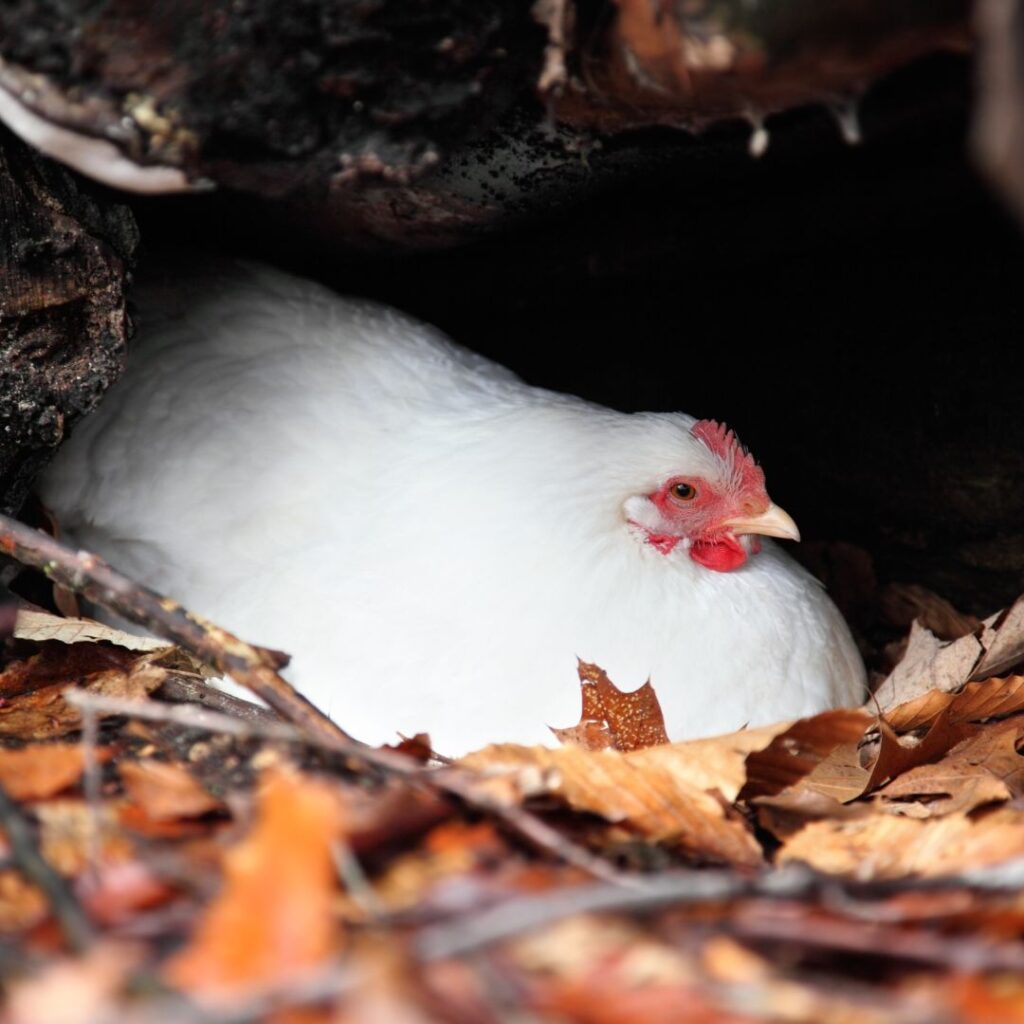
Do chickens like nesting boxes?
While some chicken owners may opt to nest on the ground or in other areas around the coop or run, most chickens prefer having access to a designated nest box that provides security while laying eggs.
How many nesting boxes do chickens need?
Chickens should be given one nesting box for every four chickens to lay in. Your hens don’t need their own nesting boxes. They will share throughout their laying time.

How many nesting boxes Are needed for four chickens To Lay Eggs?
Only one nesting box is needed for one to four hens.
How many nesting boxes for 15 Hens?
Only three nesting boxes are needed. However, I’d round up to four nesting boxes in this case.
How many nesting boxes for 100 Hens?
The same rule of thumb holds for larger flocks as small flocks, one nesting box per four hens. You would need 25 nesting boxes for a flock of 100 hens.
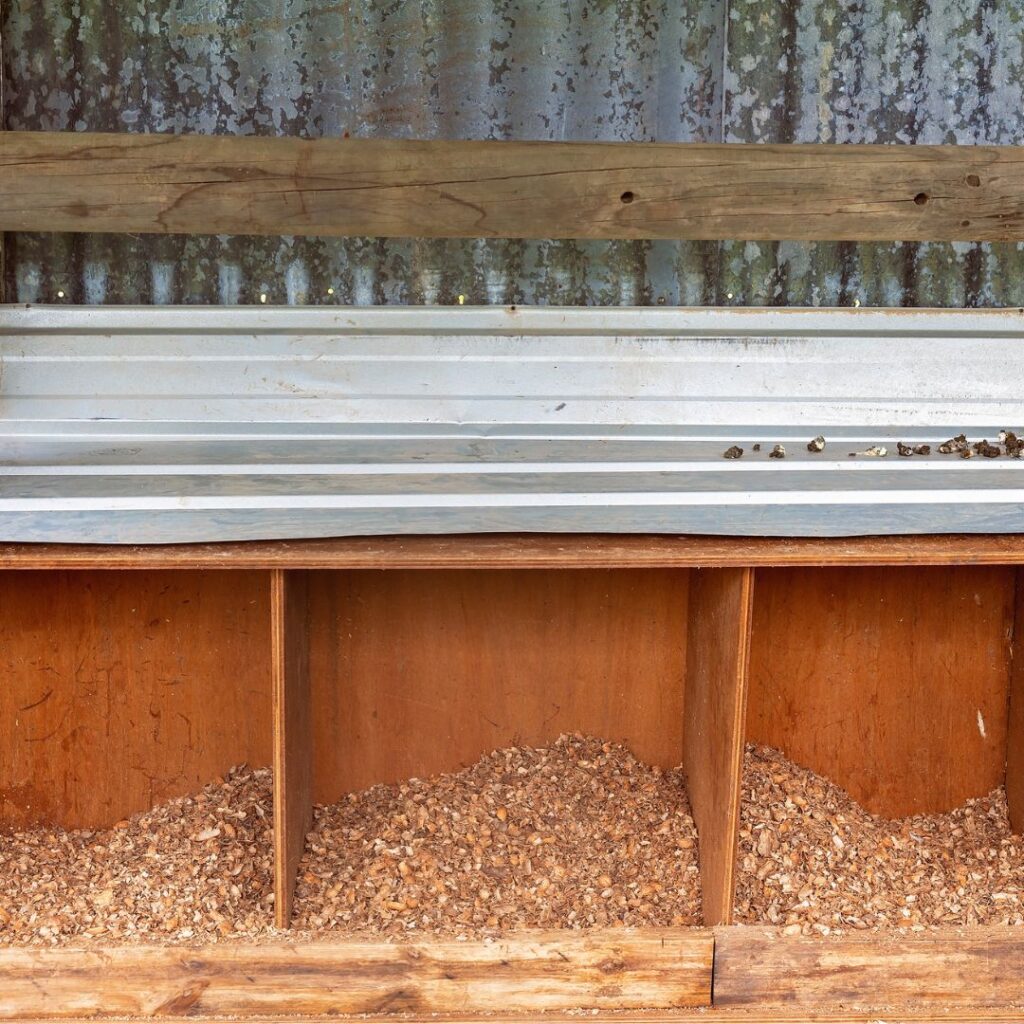
What To Consider When Picking A Chicken Nesting Box
The chicken breed size. A good rule of thumb for a chicken nesting box size is 12″ square for standard-size breeds and 18″ square for larger birds.
If you have a mixed flock of standard and larger birds, you will need to have all the nesting boxes the size the largest breed requires. For example, you have a flock of Rhode Island and New Hampshire reds (standard sized) and add in a few Jersey Giants; this would mean you’d need all your nesting boxes to be large enough to accommodate the largest hen, the Jersey Giant.
Bantam chickens only need eight square-inch square boxes.
Will you be collecting eggs from inside the coop (old school), or do you want your eggs to roll out to an outside collecting tray?
There are the things you want to think about as you’re planning your coop size.
Where To Place A Nesting Box For Your Hens?
The location of the boxes should be away from doors and drafts. The placement will allow a safe and secure place where chickens to lay.
How high should nesting boxes be in a chicken coop?
Height of the nesting boxes needs to accommodate chicken breed needs. Boxes need to be a minimum of 18″ off the floor and a maximum of 36″ off the floor. Heavy breeds like the Cochin hens and Cornish Heritage Hens can injure themselves, hopping too high. In this case, you can put a ramp-style board to allow hens up to higher box areas.

What Materials Should Be Put Inside Chicken Nesting Boxes?
The purpose of lining your boxes is to allow your hen’s eggs to avoid breaking/cracking. Almost any loose nesting material will likely get kicked around and often pushed out, so keep it simple and affordable.
Pine Shavings – preferably the large flaked pine shavings, for thicker bedding material and easier clean up. Not all wood shavings are the same, be sure to check that no chemicals were used and that your shavings are too ‘dusty.’
Note: Some chicken keepers have moved away from shavings because of toxicity concerns. I have never had a problem, but suppliers vary, and so does quality.
Clean-dried wood chips can be used, but make sure the wood is untreated and thoroughly dried.
Straw is the best, safest bedding material if you are not using liners or pads.
Hay is also a safe bedding option.
Compressed Pellets under a thinner layer of pine shavings, straw, or hay will make for easy clean-up.
A mixture of dried leaves (be sure not to allow any moist, moldy leaves) and dried pine needles- Although, yes, you guessed it, if your pine needles aren’t dried out from an entire season in the sun, you run the chance of a pine sap getting stuck on your chickens (which could lead to pecking by other hens) as well as your eggs. Many chicken keepers use these, but I’ll keep the pine needles for garden mulch.
Many chicken keepers use sand. However, coarse-grain sand can wash the bloom off your freshly laid egg, exposing the inside to bacteria. Sand ‘boxes’ should be used for eggs that will be cleaned and refrigerated immediately.
The upside to sand is how easy it is to clean (a kitty litter scoop). The downside is that sand is dusty and can retain moisture if you don’t faithfully clean the box.
I think sand should be left to the dust baths.
Nesting pads are typically disposable pre-made nesting materials from natural materials. These are good if you’re leaving the clean-up to someone while on vacation and worthwhile having a handful on hand.
There are similar soft rubber pads (looks real but it’s a mock rubber nest) you place at the bottom of your nesting box. The only problem can be if your larger hens are moving around a bit, they could break their egg.
These are still well worth placing in standard-size boxes and underneath nesting materials, making the area much easier to clean. Reusable nesting pads are more affordable in the long run.
Nest Box Liners are another reusable item in place of nesting materials getting tossed out every day as your hen lays. These are the best option if your nesting boxes are set up for eggs to roll to an outer egg collection area.
All the items you need can be easily found in a Google search or on Amazon; just put “nesting box parts” into your search.
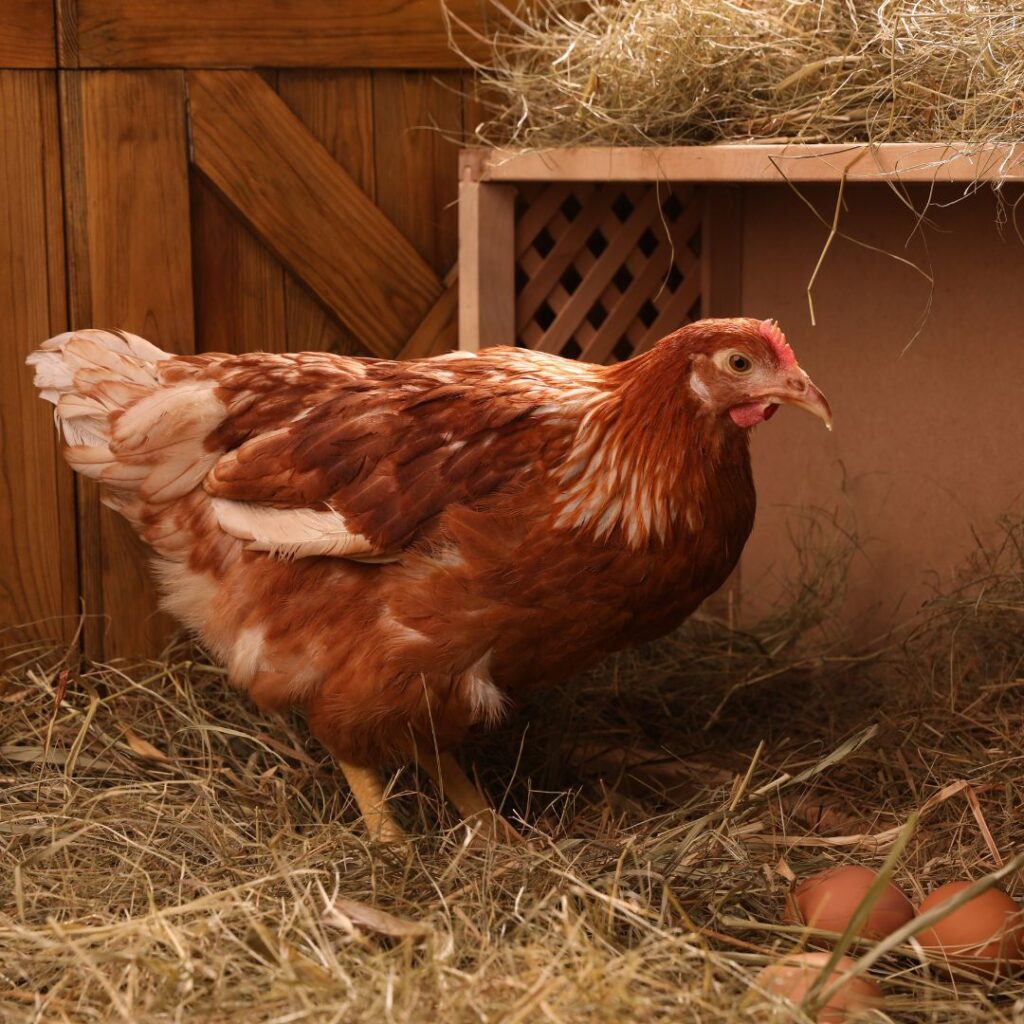
What nesting material To Avoid
Shredded paper will get dirty in a few minutes, making it unsanitary. Shredded newspaper tends to hold moisture, and ammonia builds up quickly, which is toxic to chickens.
Cedar shavings can contain toxic chemicals, and when inhaled by your hens, this can be dangerous to their respiratory systems.
Freshly fallen leaves can still retain some moisture and may start building up mold, which is dangerous to your flock. If you’re using dried-up leaves or pine needles, be sure they are turned and exposed to sunlight to dry out thoroughly.
Cat Litter is an absolute no-no for your hens’ nest boxes. It is filled with chemicals to absorb cat urine. It’s dusty and downright dangerous to put in with your hens anywhere in the chicken coop.
Lining Nests; How Much is enough?
Line your hens’ boxes with 1-3″ of bedding. Heavy and large birds like Cochins, Brahma, and Jersey giants can break eggs with their weight. Larger breeds need more bedding.
How Often To Clean A Nesting Box
Refresh bedding every few days or as needed. Every 2-3 weeks, scrape any mess, brush it out and spray with a coop-safe cleaner. Replace all bedding with fresh, clean litter/bedding.
Taking these steps will help your egg cleaning a much more pleasant task.
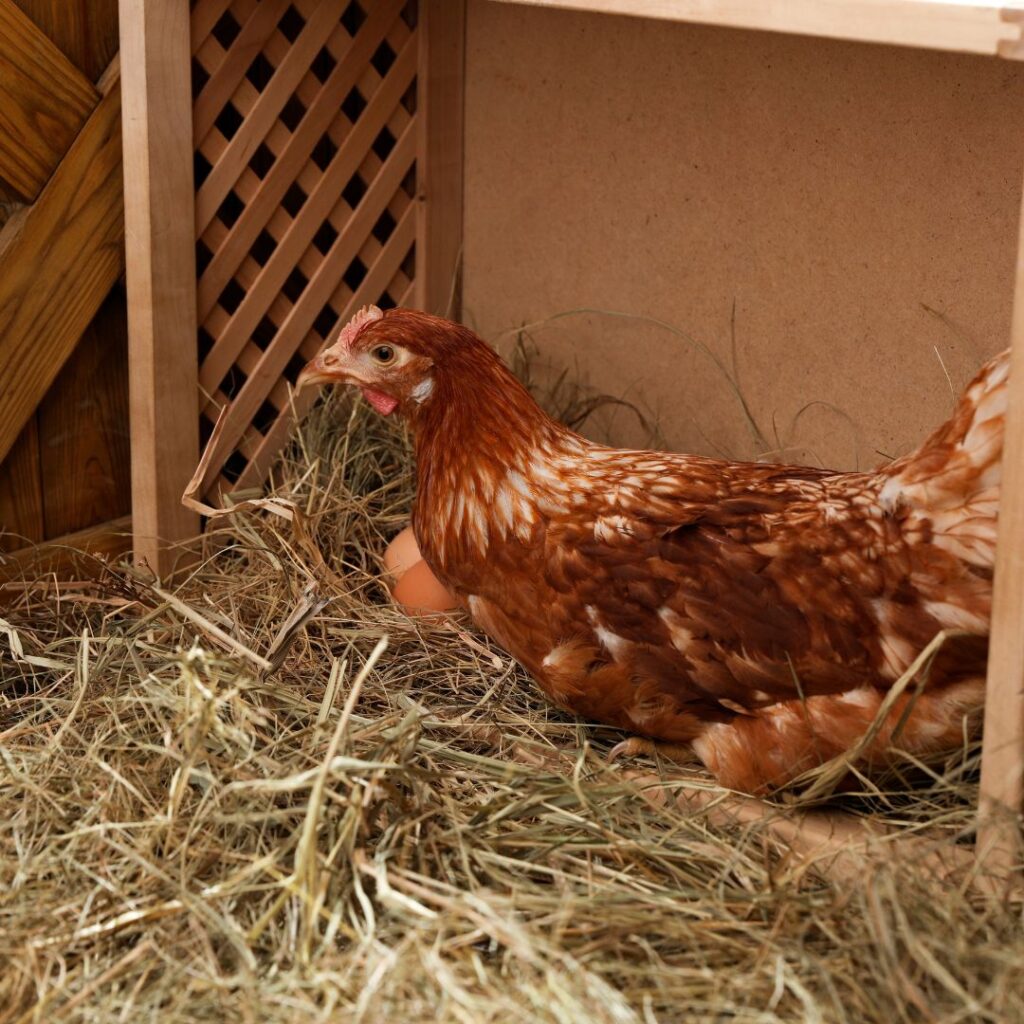
Training Hens to Lay In Nest Boxes
Start by making sure you have enough boxes for each chicken.
Be sure boxes are installed and ready at least a month before you anticipate laying to begin.
Place a fake wooden or plastic egg or golf ball in the box to encourage the ‘idea’ early on.
Be sure you are collecting any ‘stray’ eggs regularly and possibly put a box or branch in the place you want to distract them from. Typically, chickens lay eggs in the mornings, so it’s easy to get in there early in the day and scoop up any random eggs laid on the floor.
Learn more about helping chickens lay eggs in the winter here.
Pre-Made Nest Boxes For Chickens
Ready to get your chicken nests up and ready but only have a little time? You can purchase a sturdy, ready-made nesting box from your local grain store or right online. There are many options like this 2 pak of easy-to-install and clean chicken nesters, nesting boxes.
DIY Chicken Nesting Box Ideas
You can use wood from an old project, pallets, and tools around your home. While these involve carpentry skills, you can fashion an inexpensive nesting box for minimal cost. Youtube, Pinterest, and Google have great ideas and free plans.
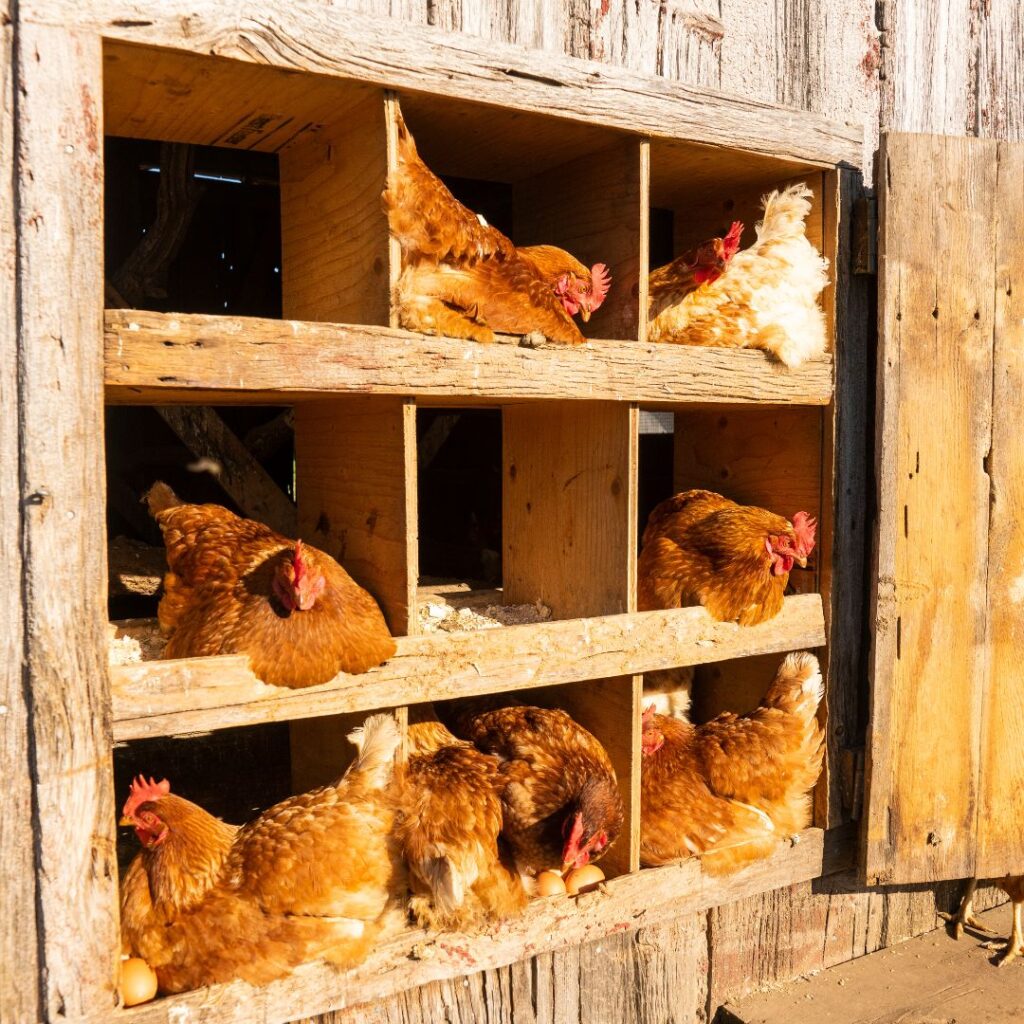
Free Nesting Box Ideas For Your Hens
Milk Crates, plastic wooden, and even metal-nesting boxes can be easily made from these by simply placing them on their sides. Remember, the crates with holes should have the bottoms covered up with a plastic mat, piece of wood, or even cardboard which can be composted.
Rubber Storage Bins can be placed upside down and cut out an opening using a sharp cutting tool. Sand down the cut edges, so they don’t harm your hens. You can even leave the lid on, making for much easier cleaning.
5 Gallon Pails on their sides and secured with screws are great too. Add an edge to the front, so the eggs don’t fall out.
Child’s large plastic pails are great for bantams.
Wooden crates are fashionable and make great nest boxes for hens when laid on their sides. Be sure any floor cracks are lined to avoid your hen catching her legs in these spaces.
Wood Bushel Baskets are secured to a shelf with a few nails or screws and a front piece of wood to keep eggs from rolling out.
Wooden Boxes you may have around from an older project on its side.
Shelving units laid on their sides with a few modifications work great and give you multiple boxes at once.
Dog Crates and Cat Crates can usually be found in Facebook marketplace for free. These come apart quickly for cleaning. Remove the door from the crate before using it for your nesting box.
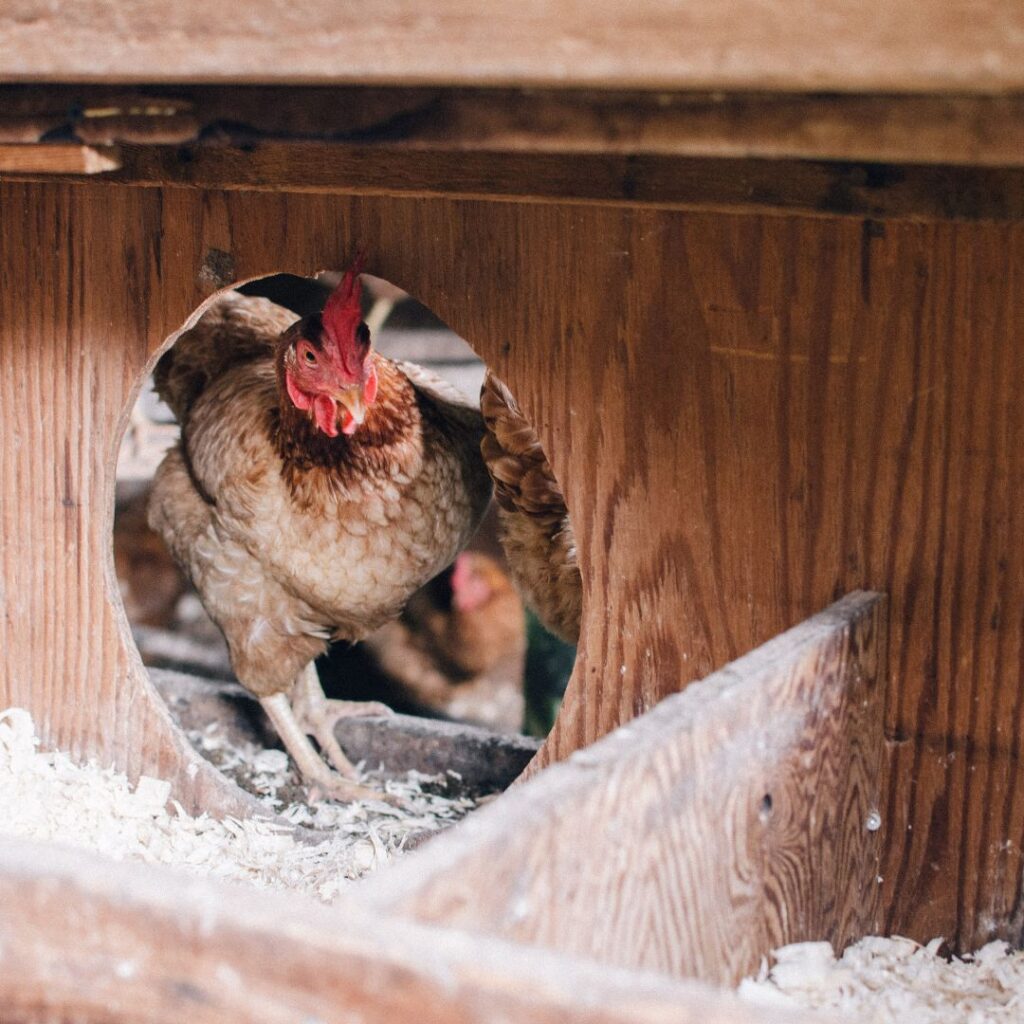
Is it Wrong For chickens to sleep in the nest box?
Some hens love sleeping in the nest box. The sleeping hen isn’t really the problem.
However, it can mean that the eggs get very dirty as chickens produce a lot of droppings in one night. The droppings accumulate in the nesting area, making it messy and unsanitary for the hens. There’s also an increased risk of egg breakage. Not to mention the added clean-up of the nest bedding every morning.
Why Your Hens Are Sleeping In The Nesting Boxes & How To Stop It
Age And Health of Hen
Aging, frail, or injured birds will retreat to a safe nest to protect themselves from further injury or getting picked n pecked upon by the other girls in the flock.
Height Of Nesting Boxes
Different breeds can leap, flutter, and even fly to a great roosting space, while others need the red carpet, the ramp up the 2nd floor, the nesting box.
Nesting box placement is a big deal for your hens. Make sure no roosts are above the roosting boxes, and never place the nest floor higher than 36.”

Most Common Problems With Nesting Boxes
Are your hens not laying in their nesting boxes? There could be a couple of causes, such as improper placement (should be located away from drafts) or too much competition between different hens (usually happens when there aren’t enough nests or coop space per hen).
Have you increased your flock size? Overcrowding in the chicken coop and roosting space could be to blame.
Despite being relatively low-maintenance, some common problems still arise with chicken nesting boxes.
Are chickens using the top of the box as their roosting area? Hens prefer a quiet nest space to lay. Try placing a board securely at an angle above the boxes to deter roosting on top of boxes. Also, relocate any roosting/ perching areas that are above the boxes. This will also keep the boxes cleaner.
Bullying among hens? Increased flock size without increasing coop and roost size can lead to bullying and more assertion of the chickens’ pecking order.
Predators nearby? Predators can startle your hen into staying in her nest box to protect her eggs.
Broody Hens will stay in their nests to try and hatch their eggs. Yes, a broody hen will do this without a rooster to fertilize the eggs. On the reverse side, if you have a hen that is not broody you could still collect their eggs and put the fertilized eggs with a broody hen or incubate them yourself.
The age of your hen can change their ability to stay on roost comfortably. An aging hen may feel safer in a nesting box if the roosting area is crowded or not sturdy enough underfoot.
Injured hens will do the same as an aging hen and look for a more secure area to rest. If this is the case, you can tend to the hen’s ailment and provide an extra nesting box for her recovery.
Dirty eggs, or eggs in messy nests. If an egg broke in that nesting area and went unattended, you’d understand the hen’s side. Your boxes need to be cleaned at least weekly and more often as needed.
If these problems don’t exist, there could be issues such as too small of a space (a 12-inch square is ideal for most hens). However, larger breeds need a large nesting box.
Examples of some larger breeds that need a large nesting area are the New Jersey Giants, The Brahma, and Naked Neck chickens.
You can add a fake wooden or ceramic egg to the nest to hint where to go. Putting golf balls in chicken nests are a great alternative to using for the fake egg replacement.
Check the bedding and refresh the nesting boxes regularly when they start laying eggs; you want to be prepared.

Conclusion:
Chicken nesting boxes play an integral role in keeping backyard flocks happy and healthy by giving hens a safe space to lay their eggs without fear of predators or disruption from other chickens rivaling for space in communal nests.
This doesn’t need to be a budget buster either. There are many affordable options and ideas available online, so don’t worry if you need more funds – make sure that whatever option you choose meets all safety requirements before bringing it home.
Your hens will be laying for a while. Depending on the breed it could be up to 5 years, so be sure to invest in something that will give back to you for many years. Find out more about how long chickens lay eggs for in this article.
By following best practices such as lining with soft materials, changing bedding regularly, ensuring enough nests per number of backyard chickens present, and ensuring proper placement of nests away from drafts – you’ll have no problem finding success with chicken nesting boxes.


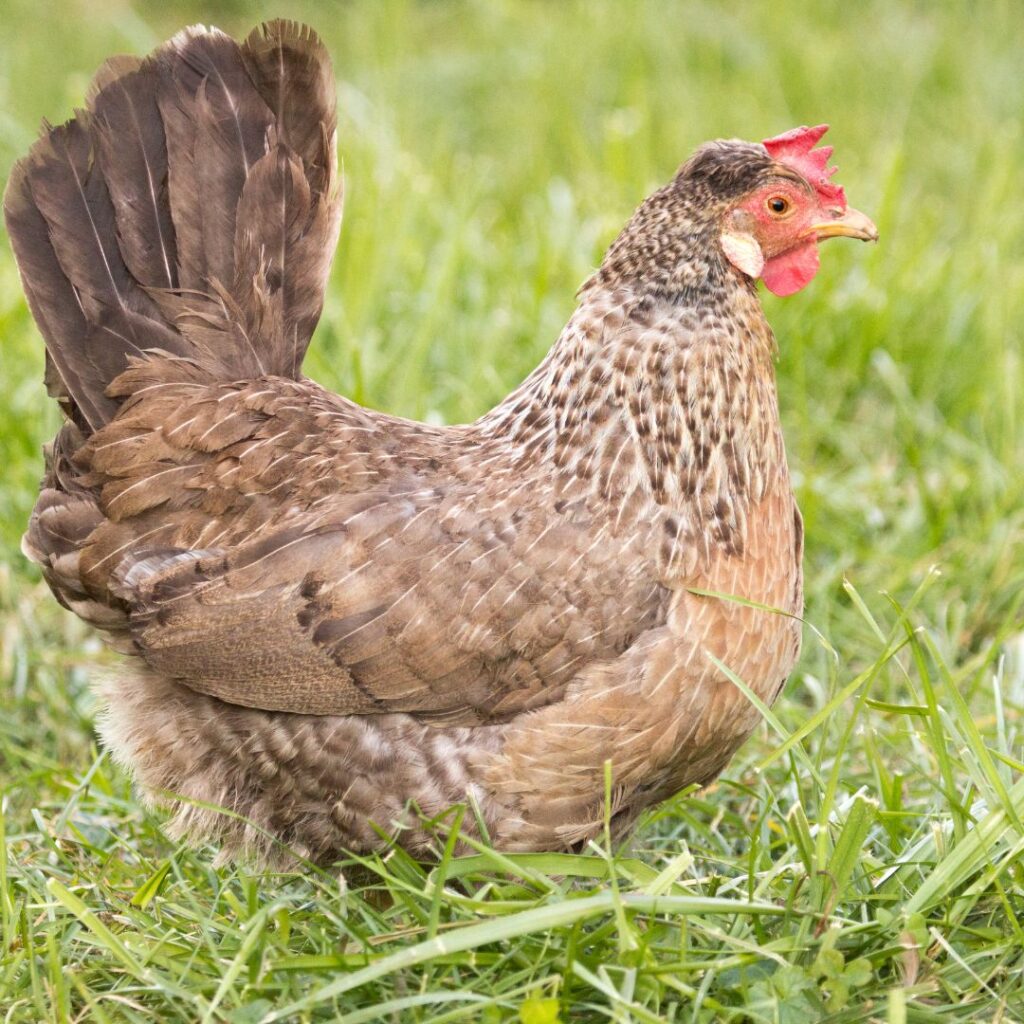

Pingback: Buckeye Chicken Breed; Only American Breed Developed By A Woman
Pingback: ISA Brown Chickens; Prolific Egg-Laying Hybrid Chickens -About